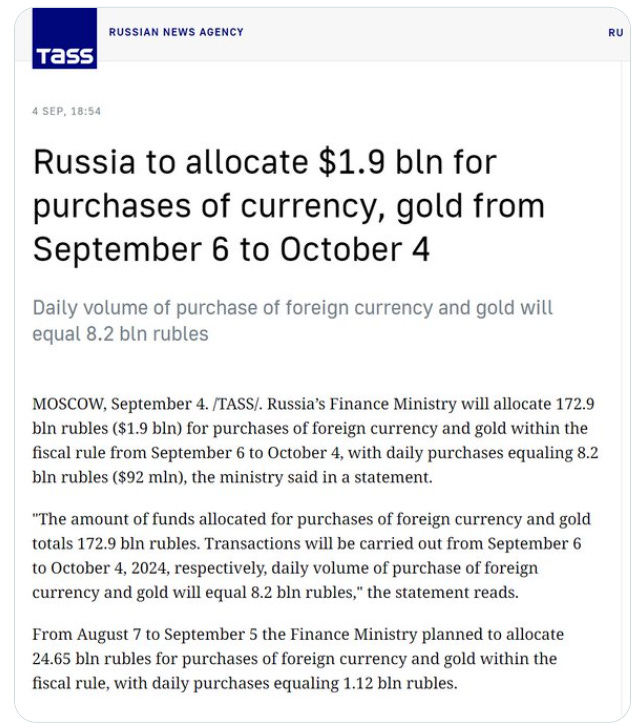As a precious metals journalist, I frequently encounter skeptics I call "gold bashers." These critics dismiss gold as an "ancient relic" or "boomer rock," questioning its practicality in modern transactions. They often present weak arguments that require considerable effort to refute.
These skeptics seem to have fallen victim to the intentional gaslighting orchestrated by fiat currency proponents, who aim to suppress interest in alternatives to Federal Reserve notes and financialized products.
Despite these challenges, it's crucial to educate people about the enduring value of gold and its role in a diversified financial landscape. The persistence of these misconceptions underscores the importance of continued dialogue and informed discussion about precious metals in today's economy.

Russia will increase its gold purchases from 1.12 billion rubles per day to 8.2 billion rubles per day for the next month.
- The large ruble amount (8.2 billion) is approximately 7.32 times larger than the smaller existing amount (1.12 billion).
- We can say that 8.2 billion is about 7.32 times larger
- or an increase of 732% over the existing 1.12 billion.

According to recent reports, Russia and China have turned to using gold as a means of payment for goods due to mounting challenges in conducting traditional banking transactions. This shift in payment methods has been prompted by increased pressure from U.S. sanctions and threats of secondary sanctions on entities dealing with Russia.
The new arrangement involves a multi-step process. First, gold is purchased in Russia. It is then transported to Hong Kong, where it is sold. The proceeds from these sales are subsequently deposited into local bank accounts.
This workaround allows both countries to continue trade relations while circumventing restrictions on conventional financial channels.
The process has not been without its complications. Russian entities have had to resort to hiring couriers to physically transport documents across the border to obtain necessary seals and signatures from Chinese bankers.
This highlights the lengths to which these countries are going to maintain economic ties in the face of international sanctions.
These developments underscore the growing tensions between Russia, China, and Western nations, particularly the United States. As geopolitical pressures continue to mount, it's likely that we'll see further innovations in cross-border transactions and trade mechanisms between sanctioned countries and their partners.
The Russia-India Gold Connection
According to leaked documents, Russia has established a covert trade channel with India to acquire sensitive goods and explore the possibility of building facilities in the country to secure components for its war efforts. This secret arrangement involves the exchange of critical electronics from India in return for Russian oil.
Key points of the article include:
Trade Details
- Russia is seeking to obtain sensitive goods from India, including electronics that could potentially be used for military purposes.
- The trade involves India selling critical electronics to Russia in exchange for oil.
Strategic Implications
- This arrangement allows Russia to circumvent Western sanctions and obtain necessary components for its military operations.
- India benefits from discounted oil prices while gaining a market for its electronics industry.
While this trade channel has been described as "secret," some commentators argue that it was a known consequence of sanctions, with the intention of reducing Russian profits while allowing oil products to reach secondary markets
Concluding thoughts
Jon Forrest Little provides his two cents
As a gold analyst, I find profound irony in the characterization of using gold as a "workaround" for international trade. In fact, one could argue that it is fiat currency that represents the true "workaround" in the history of monetary systems.
Gold has served as a universal medium of exchange and store of value for millennia, long before the advent of modern banking and fiat currencies. Goid’s intrinsic value, scarcity, resiliency, fungibility, portability, divisibility, utility, ductility, malleability, and durability (gets stronger under laser attacks) made it the natural choice for facilitating trade across borders and cultures.
Fiat currencies, on the other hand, are relatively recent inventions, backed solely by government decree rather than inherent value.
They were introduced as convenient substitutes for gold, essentially serving as promissory notes for real money - gold itself.
In this light, the return to gold-based transactions between Russia and China isn't so much a workaround as it is a reversion to a more fundamental and time-tested form of economic exchange.
It highlights the enduring value of gold as a reliable store of wealth and medium of trade, especially in times of geopolitical uncertainty and financial restrictions.
